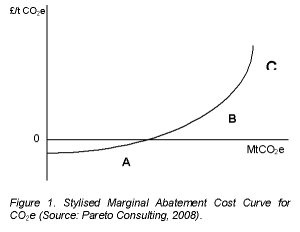Determining Cost-Effective Climate Change Activity In Agriculture, Land Use And Forestry
Published on 8 January 2009 in Climate, water and energy
Podcast
Alternative content

Introduction
This project examined the relative costs of different methods and technologies for reducing greenhouse gas emissions in agriculture and forestry. Emissions from agriculture, land use, land use change and forestry (ALULUCF) are a significant percentage of UK emissions and as the UK and Scottish Governments set ambitious emissions reduction targets the ALULUCF sectors will come under increasing pressure to reduce emissions.
Yet while there is a range of technically feasible ways of reducing emissions in these sectors, it is not immediately apparent which options will deliver the most economically efficient reductions in greenhouse gases.
As such, this briefing reports recent work, for the newly appointed Committee on Climate Change (CCC), which sought to identify the most cost-effective ways of reducing emissions in the ALULUCF sectors.
Key Points
Assuming a policy environment that allows or promotes the adoption of emissions mitigation measures, our analysis suggests that by 2012 ALULUCF could be mitigating around 6% of current greenhouse gas emissions. By 2022 this rises to nearer 25%. In other words, by 2022 the ALULUCF sectors could reduce their emissions by 25% (table 1). Estimation of abatement potentials is, however, clearly influenced by the policy environment and the expected levels of adoption of these measures.
|
Year
|
MtCO2e
|
% reduction from 2005
|
|
2012
|
2.66
|
6
|
|
2017
|
6.58
|
15
|
|
2022
|
10.83
|
25
|
Table 1: Estimates of total emissions reductions for 2012, 2017 and 2022
Our results suggest that all three sub-sectors (agriculture, land use and forestry) offer measures capable of delivering abatement at zero or low cost. Indeed around 6.34 MtCO2e could possibly be abated at negative or zero cost. If land managers adopted some of the measures, they would actually save money whilst mitigating greenhouse gas emissions.
Research Undertaken
Since the Government recognises the need to achieve emissions reductions in an economically efficient manner, it requires information on which emissions reduction measures will be most cost-effective. The research by SAC and partners therefore sought to establish the relative cost-effectiveness of the different options by developing marginal abatement cost curves (MACC) for the different sectors.
A marginal abatement cost curve represents the relationship between the cost-effectiveness and abatement potential of different options (figure 1). In figure 1 the y-axis shows cost-effectiveness and the x-axis shows abatement potential. Moving along the curve from left to right the cost-effectiveness decreases (i.e. each tonne of CO2e mitigated becomes more expensive) as the level of mitigation increases. Different mitigation measures will occupy different positions on the curve. Some measures may be able to reduce emissions and save money (A); other measures may reduce emissions more, but incur a positive cost (B/C).

In order to position the different mitigation options in the ALULUCF sectors on this sort of curve, this research developed a methodology based on guidelines supplied by the CCC. The project focussed predominantly on CO2 abatement in forestry and non-CO2 gases (methane and nitrous oxide) in agriculture and land use. A range of specific abatement measures were identified from a variety of published and unpublished sources, with information on the relevance and applicability to UK conditions derived from expert opinion. The potential emissions abatement was then calculated with reference to a business-as-usual baseline (the projected level of emissions if the sectors continue as they are at present without much policy change) for the years 2012, 2017 and 2022.
Policy Implications
This work feeds into the efforts of the UK Committee on Climate Change. This committee has been asked to propose national carbon budgets that are part of an overall strategy of reducing emissions by adopting the most cost-effective emissions reduction measures. The Committee will consider opportunities for future emissions reductions across different sectors including the agriculture, land use, land use change and forestry sectors (ALULUCF) and provide advice to the UK and devolved administrations as they set their carbon budgets for achieving their emissions reduction targets.
The degree to which the advice of the Committee is followed will depend on the different administrations, but before this work can fully inform policy, further research is needed. Further work is needed to include a quantitative assessment of the ancillary benefits and costs, i.e. other positive and negative impacts likely to arise when implementing some greenhouse gas abatement measures. Further work is also needed to extend the consideration of costs to the lifecycle impact of some measures.
Author
Dr Dominic Moran, SAC dominic.moran@sac.ac.uk







